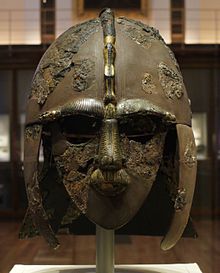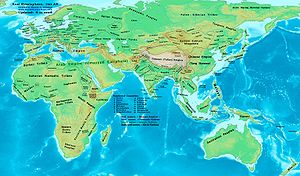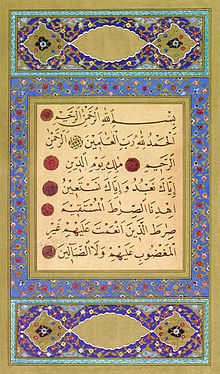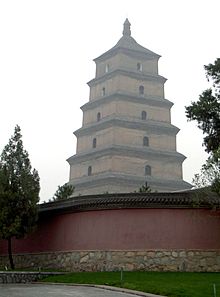
7th century
Did you know...
The articles in this Schools selection have been arranged by curriculum topic thanks to SOS Children volunteers. A good way to help other children is by sponsoring a child
| Millennium: | 1st millennium |
|---|---|
| Centuries: |
|
| Decades: | 600s 610s 620s 630s 640s 650s 660s 670s 680s 690s |
| Categories: | Births – Deaths Establishments – Disestablishments |
The 7th century is the period from 601 to 700 in accordance with the Julian calendar in the Common Era.
Overview
The Muslim conquests began with the unification of Arabia by the Prophet Muhammad starting in 622. After Muhammed's death in 632, Islam expanded beyond the Arabian Peninsula under the Rashidun Caliphate (632–661) and the Umayyad Caliphate (661–750). The Islamic conquest of Persia in the 7th century led to the downfall of the Sassanid Empire. Also conquered during the 7th century were Syria, Palestine, Armenia, Egypt, and North Africa.
The Byzantine Empire continued suffering setbacks during the rapid expansion of the Arab Empire. Although life in the countryside deteriorated, Constantinople grew to become the largest and wealthiest city in the world.
In the Iberian Peninsula, the 7th century was the Siglo de Concilios, that is, century of councils, referring to the Councils of Toledo.
In the 7th century, Harsha united Northern India, which had reverted to small republics and states after the fall of the Gupta Empire in the 6th century.
In China, the Sui Dynasty was replaced by the Tang Dynasty, which set up its military bases from Korea to Central Asia, and was next to the Arabian later. China began to reach its height. Silla allied itself with the Tang Dynasty, subjugating Baekje and defeating Goguryeo to unite the Korean Peninsula under one ruler. The Asuka Period persisted in Japan throughout the 7th century.
Events
- Islam begins in Arabia, the Qur'an is documented.
- The world's population shrinks to about 208 million people.
- The Anglo-Saxon Heptarchy emerges at the beginning of this century.
- Sutton Hoo ship burial, East Anglia (modern England).
- Xuan Zang (aka Hsuan-Tsang) traveled from China to India, before returning to Chang An in China to translate Buddhist scriptures.
- Timgad, Algeria, is destroyed by Berbers.
- End of sporadic Buddhist rule in the Sindh.
- Croats enter their present territory early in the 7th century AD, settling in six distinct tribal delimitations.
- Teotihuacan is sacked. The political and religious buildings are burned.
- The religion of Shugendo evolves from Buddhism, Taoism, Shinto and other influences in the mountains of Japan.
- The Bulgars arrive in the Balkans; establishment of the powerful Bulgarian Empire.
- Arab traders penetrate the area of Lake Chad.
- Earliest attested English poetry.
- Side panels, Basilica of Sant'Apollinare in Classe, are made.
- Main compound, Horyu-ji, Nara Prefecture, is built. Asuka period.
- 7th and 9th century – Mosaics above apse, Basilica of Sant'Apollinare in Classe, are made.
- 600: Smallpox spreads from India into Europe.
- 603: Last mention of the Roman Senate in Gregorian Register. It mentions that the senate acclaimed the statues of emperor Phocas and empress Leontia.
- 606: Boniface elected papal successor on the death of Pope Sabinian. He sought and obtained a decree from Byzantine Emperor Phocas which stated that "the See of Blessed Peter the Apostle should be the head of all the Churches". This ensured that the title of "Universal Bishop" belonged exclusively to the Bishop of Rome.
- 610: Heraclius arrives by ship from Africa at Constantinople, overthrows East Roman Emperor Phocas and becomes Emperor. His first major act is to change the official language of the East Roman Empire from Latin to Greek (already the language of the vast majority of the population).
- 615: The Sassanid Empire under Shah Khosrau II sacks Jerusalem, taking away the relic of the True cross.
- 615: Pacal the Great becomes king of the Mayan city-state of Palenque
- 616: Shah Chosroes II invades Egypt.
- 616: Aethelfrith of Northumbria defeats the Welsh in a battle at Chester.
- 618: Tang Dynasty of China initiated by Li Yuan.

- 618: The Chenla kingdom completely absorbed Funan.
- Guangzhou, China, becomes a major international seaport, hosting maritime travelers from Egypt, East Africa, Arabia, Persia, India, Sri Lanka, and South East Asia, including Muslims, Jews, Hindus, and Nestorian Christians.
- 622: Year one of the Islamic calendar begins, during which the Hijra occurs—Muhammad and his followers emigrate from Mecca to Medina in September.
- 623: The Frankish merchant Samo, supporting the Slavs fighting their Avar rulers, becomes the ruler of the first known Slav state in Central Europe.
- 626: The Avars and the Persians jointly besiege but fail to capture Constantinople.
- 627: Emperor Heraclius defeats the Persians, ending the Roman-Persian Wars.
- 629: The Byzantine-Arab Wars begin. Much of the Roman Empire is conquered by Muslim Arabs led by Khalid ibn al-Walid.
- 629– 630: Emperor Taizong's campaign against Eastern Tujue, Chinese Tang Dynasty forces under commanders Li Jing and Li Shiji destroy the Göktürk Khanate.
- 632: The Muslim conquests begin.
- 635- 649: Alopen, a Persian Christian priest introduces Nestorian Christianity into China.
- 636: Around this time the Battle of al-Qādisiyyah resulted in a decisive victory for Muslims in the Islamic conquest of Persia, the Persian Empire is conquered by Muslim Arabs led by Sad Ibn Abi Waqqas.
- 638: Emperor Taizong (627-649) issues an edict of universal toleration of religions; Nestorian Christians build a church in Chang'an.
- 638: Muslim conquest of Palestine.
- 639: Muslim conquest of Egypt and Armenia.
- 641: The Coptic period, in its more specific definition, ends when Islam is introduced into Egypt.
- 642: Library of Alexandria destroyed again.
- 649- 683: Chinese Emperor Gaozong permits establishment of Christian monasteries in each of 358 prefectures.
- 650: The Khazar-Arab Wars begin.
- Mid-7th century – Durga Mahishasura-mardini (Durga as Slayer of the Buffalo Demon), rock-cut relief, Mamallapuram, Tamil Nadu, India, is made. Pallava period. It is now kept at Asian Art Archives, University of Michigan, Ann Arbor.
- c. mid-7th century – Dharmaraja Ratha, Mamallapuram, Tamil Nadu, India, is built. Pallava period.
- 651: Emperor Yazdgerd III is murdered in Merv, ending the rule of Sassanid dynasty in Persia (Iran).
- 656– 661: The First Islamic civil war.
- 657: The Chinese Tang Dynasty under Emperor Gaozong of Tang defeats Western Turkic Kaganate.
- 658: Two Chinese monks, Zhi Yu and Zhi You, reconstruct the 3rd century South Pointing Chariot mechanical compass-vehicle for Emperor Tenji of Japan.
- 661: Caliph Ali ibn Abi Talib is assassinated. His successor Hasan ibn Ali abdicated the Caliphate to Muawiyah I, marking the beginning of the Umayyad caliphate.
- 663: The Tang Dynasty of China and Korean Silla Kingdom gain victory against the Korean Baekje Kingdom and their Yamato Japanese allies in the naval Battle of Baekgang.
- 664: Conquest of Kabul by Muslims.
- 668: The end of the Goguryeo-Tang Wars, as Goguryeo fell to a joint attack by Tang China and Unified Silla of Korea, the latter of which held the former Goguryeo domains.
- 670: In 670 an Arab Muslim army under Uqba ibn Nafi entered the region of Ifriqiya. In the late 670s conquest of North Africa was completed.
- 674: The first Arab siege of Constantinople begins.
- 677: Most of the Arab fleet is destroyed by Greek fire; the Persian crown prince flees to the T'ang court.
- 680: Battle of Karbala took place near Kufa which led to killing of Husayn ibn Ali and the division of Muslim community. The Bulgars subjugate the country of current-day Bulgaria.
- 683– 685: The Second Islamic civil war.
- 688: Emperor Justinian II of the Byzantine Empire defeats the Bulgars.
- 690: Pro-Buddhist imperial consort Wu Zetian seizes power and rules as Empress of China
- 691: Buddhism is made the state religion of China
- 694: Hispano- Visigothic king Egica accuses the Jews of aiding the Muslims, and sentences all Jews to slavery.
- 698: The Arabs capture Carthage from the Byzantine Empire.
- 698: Active but unofficial anti-Christian persecution begins in China
- 698: North South States Period begins in Korea.
- 700: The Mount Edziza volcanic complex erupts in northern British Columbia, Canada.
Significant people
- Abu Bakr, first caliph of Islam
- Ælfflæd of Whitby
- Aethelbert, King of Kent
- Æthelburg of Faremoutiers
- Æthelburg of Kent
- Æthelthryth
- Ali ibn Abi Talib ( 600– 661), cousin of Muhammad, fourth caliph of Islam, first Shi'a Imam
- Anna of East Anglia
- Antara Ibn Shaddad, Arab poet
- The Unknown Archont led the Serbs to the Balkans from the north
- Asparuh— Khan of the Bulgars and founder of contemporary Bulgaria
- Saint Asaph
- Augustine Eriugena, Irish scientist
- Benjamin I, Coptic patriarch of Alexandria during the Islamic Conquest of Egypt
- Bertha of Kent
- Brahmagupta, Indian mathematician
- Caedmon, English poet
- Cenn Fáelad mac Aillila, Irish scholar, died 679
- Saint Cuthbert
- Dae Jo-yeong, founder of Korean Balhae
- Eanflæd
- Emperor Gaozong of Tang (r. 649- 683), China
- Gregory the Great, ( 540– 604), Theologian, Pope, Civil Administrator of Rome
- Heraclius—Warrior Emperor of Byzantium who won numerous victories against the Sassanids (Persians)
- Hereswitha
- Hilda of Whitby, (c. 614–680)
- Huineng, (638-713) sixth and last Patriarch of Chán Buddhism
- Isaac of Nineveh (d 700) Nestorian Christian theologian
- Khalid ibn al-Walid ( 592– 642), Muslim Arab military commander who defeated the Roman and Persian empires in over eighty battles
- Li Jing, Chinese general who conquered the Eastern Turkic Khaganate and defeated the Tuyuhun Kingdom
- Li Shiji, Chinese general and later prime minister
- Narasimha Pallava, Pallava Dynasty, Tamil Nadu
- Muhammad ( 570– 632), final prophet of Islamic religion
- Pacal the Great, ruler of Maya state of Palenque
- Pulakesi II, comes to power
- Rædwald of East Anglia
- Sambandar, Saiva poet-saint of Tamil Nadu
- Seaxburh of Ely
- Sigeberht of East Anglia
- Su Dingfang, a general of the Chinese dynasty Tang Dynasty who succeeded in destroying the Western Turkic Khaganate
- Emperor Taizong of Tang ( 599– 649 AD), China
- Tirunavukkarasar, Indian poet (late 6th century-mid-7th century)
- Umar, second caliph of Islam
- Uthman, third caliph of Islam
- Withburga
- Wu Zetian, the only woman in the history of China to assume the title of Empress Regnant (Huangdi)
- Yeon Gaesomun, Generalissimo of Korean Goguryeo
Inventions, discoveries, introductions
- The Xumi Pagoda in Zhengding, China is built in 636 AD
- 650, The first Chinese Paper money is issued.
- 670s, Greek fire invented in Constantinople.
- The stirrup introduced to Persia from China, late 7th century
- Earliest known record of the game Chatrang, predecessor to Chess
- After sailing from Ethiopia, Sa`d ibn Abi Waqqas brings the first Quran to China, and establishes the first Islamic mosque of China in Guangzhou in the 630s.
Decades and years
|
|||||||||||||||||||||||||||||||||||||||||||||||||||||||||||||||||||||||||||||||||||||||||||||||||||||||||||||||||||||||||||||||||||||||||
|
|||||||||||||||||||||||||||||||||||||||||||||||||||||||||||||||||||||||||||||||||||||||||||||||||||||||||||||||||||




